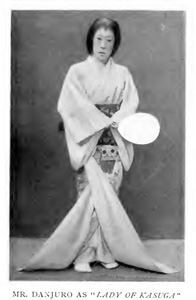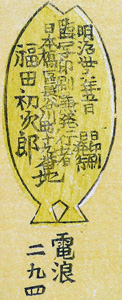About This Print
A triptych depicting the actors Ichikawa Danjūrō IX 市川 団十郎 playing the roles of Oogosho Ieyasu 大御所家康公 (right panel) and Kasuga (Lady) Tsubone 春日局 (center panel) and Nakamura Shikan V 中村芝翫 playing the role of Kaji no Tsubone 梶の局 from the play Kasuga no Tsubone, written in 1890 by the one-time journalist and politician Fukuchi Genichirō (1841-1906).

The play was performed for the first time in 1891. Given the date of this print, May 1903, it is a portrayal of Danjūrō in what would have been his last stage performance before his death on September 13, 1903.
About the Play
Source: Morikami Museum website http://www.morikami.org/index.php?src=directory&view=exhibits&refno=5718&srctype=exhibits_detail"Kasuga no Tsubone 春日局 was a historical figure from the early 17th century, the wet nurse of the third Tokugawa shogun, Iemitsu. When Oeyo, wife of the second Tokugawa shogun, Hidetada, tried to have her second son appointed heir, Kasuga no Tsubone secretly traveled to Sumpu Castle to entreat Ieyasu to intervene and restore Iemitsu, Oeyo’s first son, to his place as heir. Later, when Iemitsu became shogun, Kasuga no Tsubone took control of the O-oku, the inner palace that was occupied solely by [the] shogun’s wives and concubines and their female servants. The O-oku was first organized by Oeyo. In 1903 Ichikawa Danjuro appeared at the Kabukiza in the drama “Kasuga no Tsubone” playing three roles: Kasuga no Tsubone, Ofuku no Kata and Ieyasu. The play was a katsureki, or a “play of living history”, a genre that Danjūrō championed but which never caught on with the public. Plays in this genre were acted out with as much fidelity to historical fact as research could ascertain."
Period Comments of British Playwright and Theater Critic Osman Edwards
Source: Japanese Plays and Playfellows, Osman Edwards, John Lane 251 Fifth Avenue, New York, 1901, p. 85-86.
"The reception of Kasuga-no-Tsubone (The Lady-in-Waiting of Kasuga") one of Mr. Fukuchi's finest plays marked a most creditable advance in public judgment. Here was a piece entirely devoid of sensational incident, depending on neither love nor death nor abnormal sacrifice for its appeal, but narrating the discharge of public duty by a high-spirited woman in the face of ceaseless intrigue and danger. It brings out the noblest side of Japanese statesmanship, the farseeing wisdom and patience of the ruler, together with the perseverance and devotion of the ruled. The political and personal strands of interest are so cleverly combined, that for once the grey fabric of governmental policy is sufficiently embroidered with a pattern in gold of intersecting character: the scarlet thread is scarcely missed. Briefly this is the tale. lyeyasu, having completed his work of equipping Japan with a durable constitution, retired to Suruga, and, leaving the shogunate in Hidetada's hands, continued to take private measures for the future welfare of the State. One of these was the education of his grandson, Taketiyo (better known as lyemitsu), whom he wished to be trained in the severest school of military discipline. For this purpose he chose the Lady of Kasuga, whose husband, Inaba Sado-no-Kami, was a ronin, having been dispossessed of title and estates by Hideyoshi. The task was beset with difficulty. First the wife of Hidetada, and then that Shogun himself, lost no occasion of thwarting her efforts and of putting forward Kunityo, a younger prince, whose gentler and more refined manner gained him many partisans at Court. In despair of winning her cause, the Lady of Kasuga fled to Suruga in the garb of a pilgrim and begged lyeyasu to decide between the rival candidates. The old man thereupon returned to Yedo and subjected the brothers to searching tests of both intellectual and physical capacity. In all these the more Spartan pupil of the samurai's wife proved victorious. Up to thispoint the plot does not differ very materially from ordinary histories of disputed succession, but the last act is peculiarly illustrative of woman's status during the Tokugawa regime. Asked to choose her own reward for service so admirably rendered, the preceptress of lyemitsu solicits the restoration to her husband of his rank and states; but he, regarding such a proposal as wounding to his honour, proceeds to divorce her. lyeyasu then offers to make the wife a daimyo, but she refuses, on the ground that to accept would be to still further dishonour her husband. In the end Inaba is reinstated for having exhibited a proper spirit of pride and independence, while the Lady of Kasuga resumes her place at his side."
The Actors Pictured
For background on the actors Ichikawa Danjūrō IX and Nakamura Shikan V see their respective entries in the article The Kabuki Actor on this site.Print Details
| IHL Catalog | #665 |
| Title (Description) | Kabuki-za Shin Kyōgen 歌舞伎坐新狂言 (New Play at the Kabuki-za); Note: The name of the particular play is not seen on the print but is identified in the Tokyo Metropolitan Library database as Kasuga no Tsubone 春日局. |
| Artist | Utagawa Kunimasa IV (1848-1920) |
| Signature | Utagawa Hōsai hitsu |
| Seal | rectangular Baidō seal |
| Publication Date | May 1903 (Meiji 36, 5th month) 明治卅六年月 |
| Publisher |  The characters 電浪 二九四 appearing below the seal may be the publisher's phone number, although "telephone" is normally seen as 電話 ("denwa") instead of 電浪 ("denrō") as written here. |
| Impression | excellent |
| Colors | excellent |
| Condition | good- full-size; minor soiling; mounting remnants top corners verso of each sheet |
| Genre | ukiyo-e; yakusha-e |
| Miscellaneous | |
| Format | vertical oban triptych |
| H x W Paper | 14 5/8 x 9 7/8 in. (37.1 x 25.1 cm) each sheet |
| Literature | |
| Collections This Print | Tokyo Metropolitan Library N034-001 |


